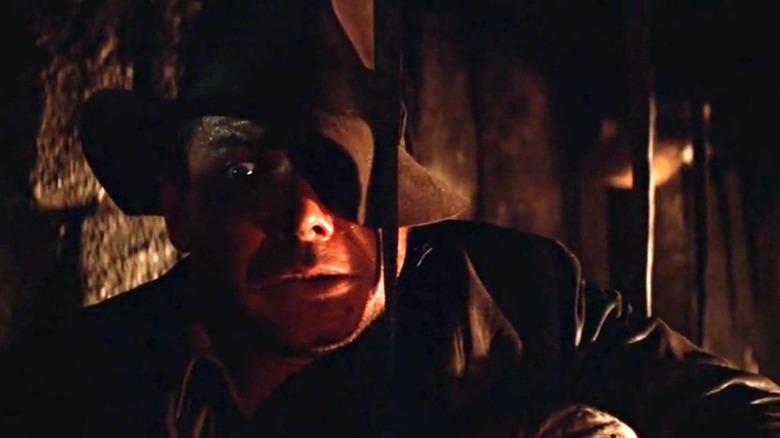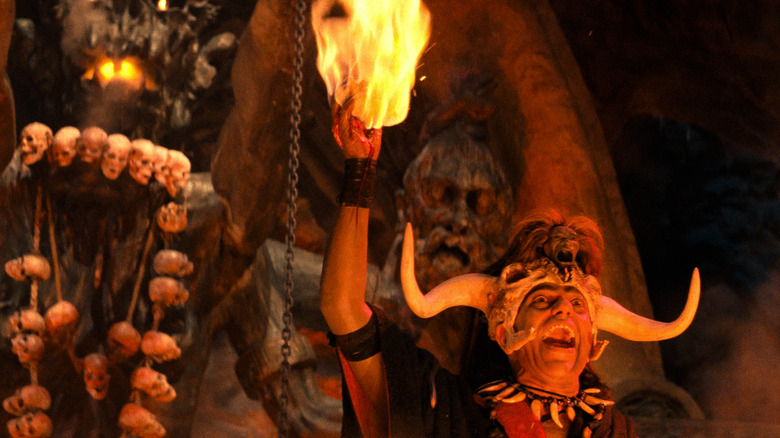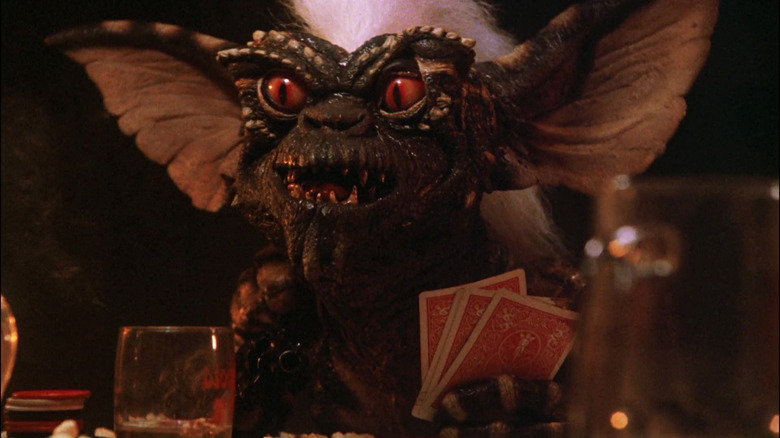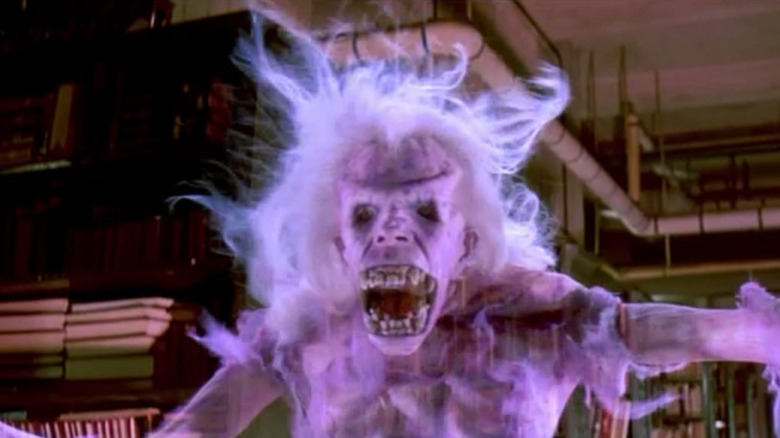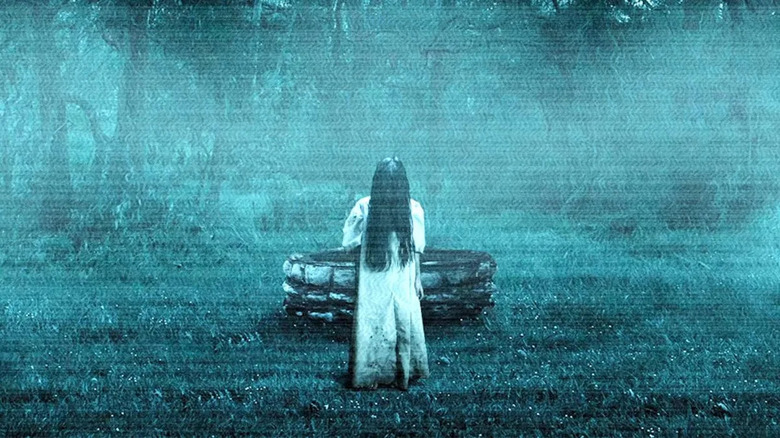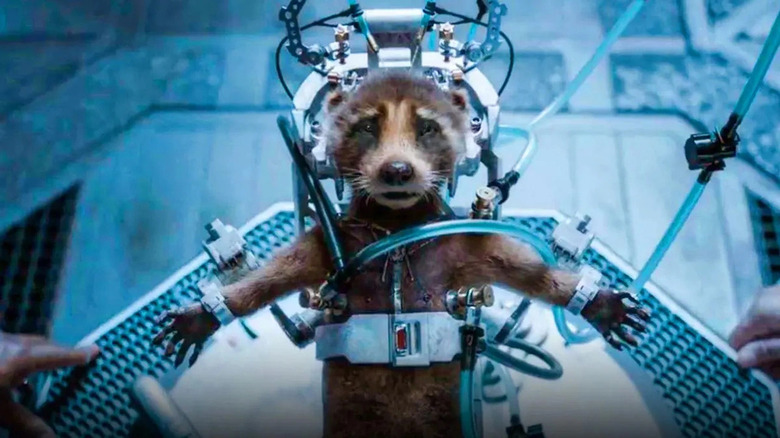How The 'Stealth Horror' Of Two Steven Spielberg Productions Helped Create The PG-13 Rating
It may not feel like it, but the ratings system used for movies that is administered by the Motion Picture Association of America is still an ongoing work in progress. Granted, the system has seemingly been fully established for the last 30-odd years or so, with the last major hiccup being the creation and controversial usage of the NC-17 rating during the 1990s.
Still, it only takes a cursory glance at the recent cinematic landscape to see that there's a remarkable imbalance in the way the ratings system has been used over the past couple decades. Upon the introduction of a "middle ground" rating between PG and R, the PG-13, the system began to slowly be skewed to the point where now G and PG-rated films are almost exclusively the purview of children's movies (with the G rating itself nearly fully retired by circumstance). PG-13 has far and away become the most common rating, the expected (and, in many cases, demanded) label for any and all big-budget films.
Marvel Studios' recent "Guardians of the Galaxy Vol. 3" is a PG-13 rated movie, yet its content is causing a little bit of controversy, with some people claiming it's too extreme for its rating. While that debate is still underway, "Vol. 3" is remarkably similar in its intensity and aesthetics to the two films that infamously gave birth to the PG-13 rating: 1984's PG-rated "Indiana Jones and the Temple of Doom" and "Gremlins." Simply put, all three of these movies delve heavily into the horror genre, and it's our culture's still-wonky relationship with horror that seems to lead to such controversy.
The stealth horror of 'Temple of Doom'
Steven Spielberg doesn't tend to be generally considered a horror director, and yet his career quite clearly owes a debt to the genre as well as being steeped in it. After all, his first big job as a hired director was for an episode of Rod Serling's "Night Gallery," his breakout second feature was the horror adventure film "Jaws," and his first few co-productions as a producer included "Poltergeist" and "Twilight Zone: The Movie."
It's not at all surprising, then, that there are horrific elements in his films: from the eerie home invasions by aliens and the government in "Close Encounters of the Third Kind" and "E.T.," to the melting faces during the climax of "Raiders of the Lost Ark," Spielberg frequently employed horror imagery during the early phase of his career. That imagery seemed to culminate in "Indiana Jones and the Temple of Doom," whose plot sees Indy (Harrison Ford), his kid sidekick Short Round (Ke Huy Quan), and a temperamental club singer, Willie (Kate Capshaw) discovering a still-active Thuggee voodoo cult in 1935.
The co-creator of Indy, George Lucas, came up with the film's story, and hired his "American Graffiti" collaborators Willard Huyck and Gloria Katz to write the script; Huyck and Katz just so happen to be the filmmakers behind one of the spookiest atmospheric horror films of all time, 1973's "Messiah of Evil," and they bring a lot of that mood to "Temple." As the movie is, essentially, "Indiana Jones Goes to Hell," elements like still-beating hearts being pulled out of bodies, Indiana being possessed by Evil, and human sacrifice make "Temple" into a stealth horror film, one that turned out to be a little too intense for a PG rating.
Turning 'Gremlins' from a R horror script into a PG horror adventure
Where "Poltergeist" was clearly a horror film from the start and the "Indiana Jones" films were never expressly intended as children's movies (despite Lucas' involvement meaning an abundance of marketing licensed products to kids), "Gremlins" courted controversy by being marketed in an insidiously clever fashion, riffing on the runaway popularity of Spielberg's family-friendly "E.T." by putting the adorable Gizmo front and center.
Despite Gizmo's cuteness, "Gremlins" began life as a spec script by writer Chris Columbus that was intended as a far more gruesome horror comedy. In that original version, Gizmo would actually become the evil Gremlin, Stripe, the Gremlins ate people, and the fates of certain characters like the hero's mother were horrifically violent. Yet Spielberg convinced Columbus that, as the writer recalled in 2020, he could rewrite the script to "reach a much wider audience."
So, Gizmo remained good, and the Gremlins' antics became toned down. Yet Spielberg still hired Joe Dante to direct, a filmmaker who was mentored by genre guru Roger Corman and whose first few films included the "Jaws" riff "Piranha" and the werewolf movie "The Howling." As such, the horror elements of "Gremlins" are still very much present in the finished film, most famously during the sequence where Mrs. Peltzer decides to fight back against the malicious monsters and ends up puréeing one in a blender while exploding another in a microwave.
While the Gremlins aren't seen killing any humans (with the exception of Polly Holiday's Mrs. Deagle), Dante and his effects crew never let the horror of the film fade away — the movie even climaxes with the death of Stripe in a gory fashion that recalls "The Evil Dead."
Horror gains increased popularity during the '80s ...
Ever since the Universal monster cycle of the '30s and '40s, horror had been a highly popular cinematic genre. Yet its respectability waned during the more repressed '50s and '60s, as horror became increasingly relegated to B-movie fare. When the explosion of permissive adult content in the '70s resulted in an increased sex and violence quotient within horror, the genre started to seem disreputable on the surface.
At the beginning of the 1980s, horror fandom was still niche, but horror movies underwent a production boom, and critics like Roger Ebert and Gene Siskel railed against what they viewed as a newly trashy genre. Despite their protestations, horror was becoming rapidly popular again, and movies like "Temple of Doom" and "Gremlins" only proved it.
Another movie that was released in the summer of '84 that managed to eschew controversy but nonetheless act as a gateway drug to horror films was "Ghostbusters," which was seen as a cuddlier effort from the "Animal House" and "Stripes" folks (a promo for Showest sees Dan Aykroyd cheekily exclaiming "I'm f—ing tellin' ya, it's PG!") that ended up kickstarting a franchise which became huge with children.
... and goes mainstream (again)
As the '80s continued into the '90s, horror franchises like "A Nightmare on Elm Street" and "Friday the 13th" became so popular that products like lunchboxes and comic books were marketed despite the series' R-ratings. Tim Burton, who resurrected the comic book movie with 1989's Hammer Horror-tinged "Batman," made one of the most subversive blockbusters ever in 1992's "Batman Returns," which was PG-13 but nonetheless came under fire from parents' groups for its horror elements. The "Scream" movies kicked off a new wave of studio-backed horror features, and filmmakers who got their start with relentlessly gory horror features soon became responsible for some of the biggest movies of all time: Sam Raimi with the "Spider-Man" films, and Peter Jackson with "The Lord of the Rings."
By the 2000s, horror had started to become fully mainstream again, and in an ironic full-circle twist, a large number of horror films began to embrace the PG-13 rating as opposed to the R, beginning in earnest with Gore Verbinski's remake of "The Ring." Though this trend helped birth the wave of "torture porn" horror films that touted extreme, hard-R violence, it nonetheless helped expand the idea of what constituted a horror film, proving once again that the genre didn't necessarily have to mean buckets of blood and gratuitous nudity.
Horror is the most honest genre
While some horror fans still balk at the idea of PG-13 horror, those in the know realize that it's the films themselves that matter and not the rating. After all, some of the biggest classics of the genre have a lower-than-R rating: not just the aforementioned "Poltergeist," but "The Sixth Sense," "Tremors," "The Gate," "Drag Me to Hell" and "Happy Death Day" are all super effective without being R-rated.
In terms of horror elements being used in otherwise non-horror movies, a training or history within the genre has been proven time and again to result in cinema that's far more rewarding than it might otherwise be. Thanks to their backgrounds within horror, filmmakers like Spielberg, Burton, Raimi, Jackson, James Gunn, and others bring a wonderful sense of drama and emotional stakes to their work that makes them that much richer and more honest. Indiana Jones' touching relationship with Short Round wouldn't be half as effective were it not for the dark goings-on surrounding them, Gizmo wouldn't seem as adorable without the contrasting slimy Gremlins, and the Guardians of the Galaxy wouldn't be as heroic if their enemies were sanitized or censored, for example.
Thanks to the somewhat unintentional efforts of Spielberg, "Temple of Doom," and "Gremlins," the stealth horror movie is alive and well, and available to all ages as well as old and new horror fans alike.
